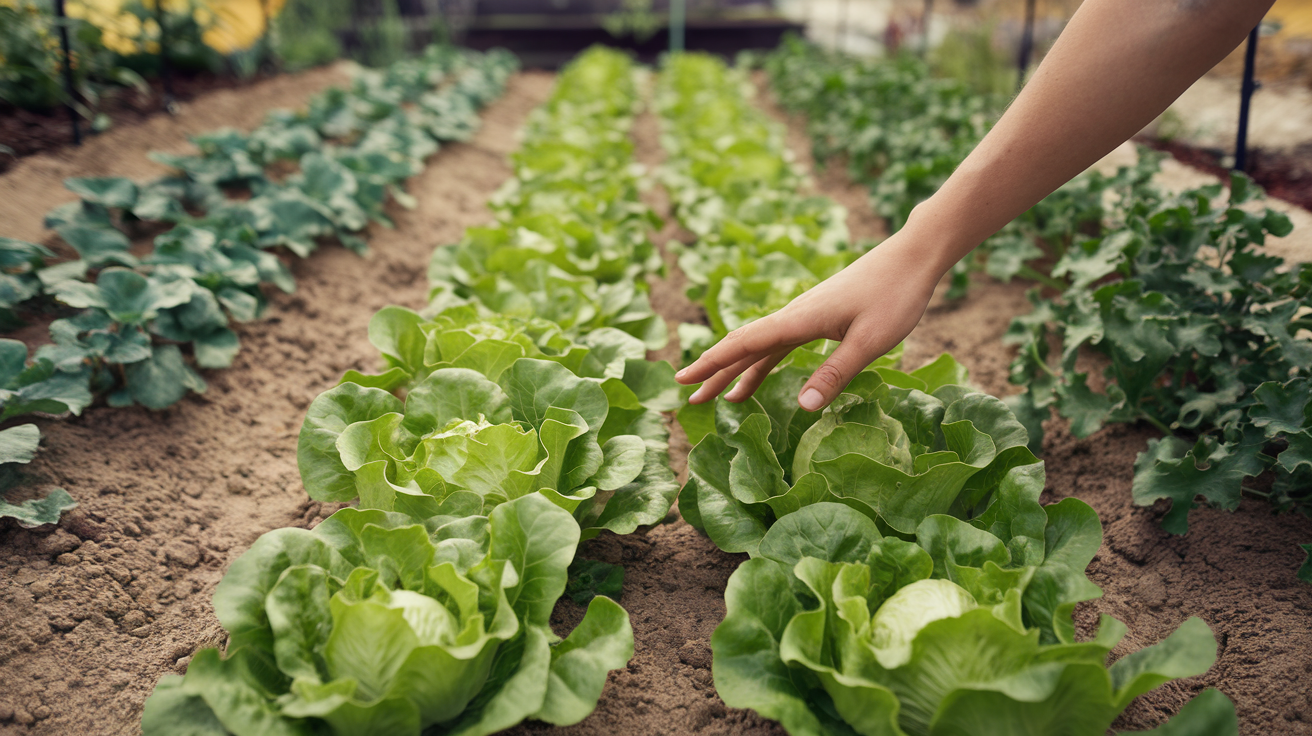Germinating lettuce seeds is the first step towards growing fresh, crisp lettuce in your garden or home. While the process may seem simple, understanding the best techniques can significantly improve your success rate and yield.
Rhys Garden will guide you through the step-by-step process of germinating lettuce seeds, offering tips on the ideal conditions and practices to ensure a bountiful harvest of this nutritious and versatile leafy green.
Understanding Lettuce Seeds
Before we delve into the germination process, it’s essential to understand the nature of lettuce seeds. These tiny powerhouses of potential are the foundation of your future salad bowl, and knowing their characteristics can significantly improve your success rate.
Characteristics of Lettuce Seeds
Lettuce seeds are typically small, oval-shaped, and can vary in color from light tan to dark brown or black, depending on the variety. Here are some key points to remember:
- Size: Lettuce seeds are generally 2-3 mm long, making them one of the smaller vegetable seeds.
- Viability: Under proper storage conditions, lettuce seeds can remain viable for up to 5 years.
- Light Sensitivity: Unlike many other seeds, lettuce seeds often require light to germinate effectively.
- Temperature Preference: Lettuce seeds prefer cooler temperatures for germination, typically between 55°F to 75°F (13°C to 24°C).
Popular Lettuce Varieties for Home Gardens
At Rhys Garden, we’ve experimented with numerous lettuce varieties. Here are some popular choices that germinate well and thrive in home gardens:
- Butterhead: Known for its soft, buttery texture.
- Romaine: Crisp and nutritious, perfect for Caesar salads.
- Loose Leaf: Easy to grow and harvest continuously.
- Iceberg: Crunchy and refreshing, ideal for warm climates.
- Mesclun Mix: A blend of various lettuce types for diverse salads.
Preparing for Germination

Successful lettuce seed germination begins with proper preparation. Let’s walk through the essential steps to set the stage for healthy seedlings.
Choosing the Right Time
Timing is crucial when it comes to germinating lettuce seeds. Here’s what you need to know:
- Season: Lettuce is a cool-season crop, making spring and fall ideal for planting in most regions.
- Temperature: Aim for soil temperatures between 60°F to 70°F (16°C to 21°C) for optimal germination.
- Daylight: Ensure your planting area receives at least 6 hours of sunlight daily.
Selecting the Growing Medium
The right growing medium can make a significant difference in germination success. Consider these options:
- Seed Starting Mix: A sterile, lightweight mix designed specifically for seed starting.
- Peat Pellets: Convenient, pre-formed growing mediums that expand when watered.
- Coconut Coir: An eco-friendly alternative to peat, with excellent water retention properties.
Gathering Necessary Supplies
Before you begin, ensure you have the following supplies on hand:
- Lettuce seeds
- Growing containers or seed trays
- Chosen growing medium
- Spray bottle or watering can with a fine nozzle
- Clear plastic wrap or humidity dome
- Labels and markers
Step-by-Step Germination Process
Now that we’ve covered the basics, let’s dive into the step-by-step process of germinating lettuce seeds. Follow these Rhys Garden-approved methods for the best results.
Method 1: Indoor Seed Starting
Indoor seed starting is an excellent way to get a head start on the growing season, especially in regions with short summers.
- Prepare the Container: Fill seed trays or small pots with moistened seed starting mix, leaving about 1/4 inch of space at the top.
- Sow the Seeds: Sprinkle seeds lightly on the surface of the soil. Remember, lettuce seeds need light to germinate, so don’t bury them.
- Cover Lightly: If desired, cover the seeds with a thin layer of vermiculite or finely sifted compost. This helps retain moisture without blocking light.
- Water Gently: Use a spray bottle or fine-mist watering can to moisten the soil surface without disturbing the seeds.
- Provide Humidity: Cover the container with clear plastic wrap or a humidity dome to maintain moisture.
- Maintain Temperature: Keep the containers in a warm area, ideally between 65°F to 75°F (18°C to 24°C).
- Monitor and Care: Check daily for moisture levels and germination progress. Remove the cover once seedlings emerge.
Method 2: Direct Sowing Outdoors
For gardeners in mild climates or those planting during the cooler seasons, direct sowing can be an effective method.
- Prepare the Soil: Loosen the soil to a depth of about 6 inches and mix in compost or well-rotted manure.
- Create Rows: Make shallow furrows about 1/4 inch deep and 12-18 inches apart.
- Sow Seeds: Sprinkle seeds thinly along the rows, aiming for about 10-15 seeds per foot.
- Cover Lightly: Gently cover the seeds with a thin layer of soil or compost, no more than 1/8 inch deep.
- Water Carefully: Use a fine spray to moisten the soil without washing away the seeds.
- Protect the Area: If birds or pests are a concern, cover the seeded area with row covers or netting.
- Thin Seedlings: Once seedlings are about 2 inches tall, thin them to 4-6 inches apart for most varieties.
Method 3: Paper Towel Germination
This method is excellent for testing seed viability or for gardeners who enjoy a more hands-on approach.
- Moisten Paper Towel: Dampen a paper towel with water, ensuring it’s moist but not soaking wet.
- Place Seeds: Spread lettuce seeds evenly on one half of the paper towel, leaving space between each seed.
- Fold and Seal: Fold the other half of the paper towel over the seeds and place it in a sealable plastic bag.
- Provide Warmth: Place the bag in a warm location, ideally around 70°F (21°C).
- Check Regularly: Open the bag daily to check for germination and ensure the paper towel remains moist.
- Transplant: Once seeds have sprouted (usually within 2-5 days), carefully transfer them to prepared soil or growing medium.
Caring for Germinated Seedlings
Congratulations! Your lettuce seeds have sprouted. Now, let’s ensure they grow into healthy, productive plants.
Lighting Requirements
Lettuce seedlings need plenty of light to grow strong and avoid becoming leggy. Here’s what you need to know:
- Natural Light: Place seedlings in a south-facing window that receives at least 6 hours of direct sunlight daily.
- Artificial Light: If natural light is limited, use fluorescent or LED grow lights positioned 2-4 inches above the seedlings for 14-16 hours per day.
- Rotating Plants: Turn containers regularly to ensure even growth on all sides.
Watering and Fertilizing
Proper watering and nutrition are crucial for healthy seedling development:
- Watering: Keep the soil consistently moist but not waterlogged. Water from the bottom when possible to avoid disturbing delicate seedlings.
- Fertilizing: Begin fertilizing with a diluted, balanced liquid fertilizer when seedlings develop their first true leaves.
Hardening Off
Before transplanting outdoor-bound seedlings, they need to be acclimated to outdoor conditions:
- Gradual Exposure: Start by placing seedlings outside in a sheltered area for 1-2 hours, gradually increasing exposure over 7-10 days.
- Temperature Monitoring: Bring seedlings indoors if temperatures drop below 45°F (7°C).
- Wind Protection: Shield young plants from strong winds during the hardening off process.
Troubleshooting Common Germination Issues
Even with the best care, you may encounter some challenges. Here are solutions to common problems:
Poor Germination Rates
If your seeds aren’t sprouting as expected, consider these factors:
- Old Seeds: Lettuce seeds lose viability over time. Use fresh seeds or perform a germination test before planting.
- Incorrect Temperature: Ensure soil temperature is within the optimal range of 60°F to 70°F (16°C to 21°C).
- Overwatering: Excessive moisture can lead to seed rot. Ensure soil is moist but not waterlogged.
Damping Off
This fungal disease can quickly kill seedlings. Prevent it by:
- Using sterile seed starting mix and clean containers.
- Providing good air circulation.
- Avoiding overwatering and overcrowding of seedlings.
Leggy Seedlings
Insufficient light leads to tall, spindly seedlings. Address this by:
- Providing more light, either natural or artificial.
- Lowering grow lights closer to the seedlings.
- Transplanting seedlings to individual containers to reduce competition.
Frequently Asked Questions
To address common concerns, we’ve compiled answers to frequently asked questions about germinating lettuce seeds:
Q1: How long does it take for lettuce seeds to germinate?
A: Under optimal conditions, most lettuce varieties will germinate within 2-8 days. Factors like temperature, moisture, and seed freshness can affect germination time.
Q2: Can I use regular garden soil to start lettuce seeds?
A: While possible, it’s not recommended. Garden soil can be heavy and may contain pathogens. A sterile seed starting mix provides better drainage and reduces the risk of disease.
Q3: Do I need to soak lettuce seeds before planting?
A: Unlike some larger seeds, lettuce seeds generally don’t require soaking before planting. However, ensuring the soil is moist before and after sowing is crucial for successful germination.
Q4: How deep should I plant lettuce seeds?
A: Lettuce seeds are very small and require light to germinate. They should be sown on the surface of the soil or covered with a very thin layer (no more than 1/8 inch) of fine soil or vermiculite.
Q5: Can I germinate lettuce seeds in water?
A: While it’s possible to sprout lettuce seeds in water, it’s not the most practical method for growing lettuce plants. Soil or a soilless medium provides better support and nutrients for developing seedlings.
Conclusion
Successfully germinating lettuce seeds is a rewarding experience that sets the foundation for a thriving lettuce crop. By following the right techniques and providing the ideal conditions, you can enjoy a continuous supply of fresh lettuce straight from your garden. As Rhys Garden, we hope this guide empowers you to start your lettuce-growing journey with confidence, leading to a plentiful harvest that adds flavor and nutrition to your meals.

Related Posts
How to Germinate Orchid Seeds: A Beginner’s Guide to Growing
The Ultimate Guide to Worms in Plant Soil: Friend or Foe?
Perennial Herbs for Zone 5: A Thriving Garden Year After Year